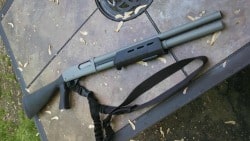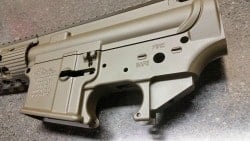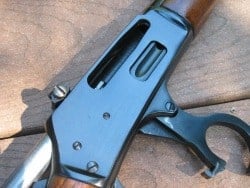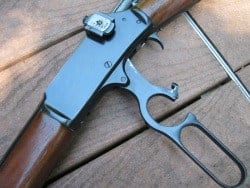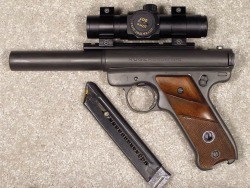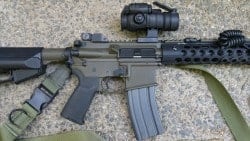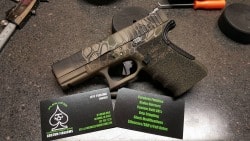We recently had a reader email into the Survival Cache team with a couple suggestions for articles he’s like to see
It’s a great question – what firearms finish will work best to protect your gun from corrosion and wear during a long-term SHTF event, or over a long duration of time between cleanings and maintenance? Well, as someone who was a professional firearms refinisher for many years, with lots of experience in cold bluing, hot tank bluing, nickel plating, and spray-on finishes, I’ll walk you through the differences of some of the most commonly encountered finishes, and the pros and cons of each. Hopefully this will help some of you decide where to plunk your hard-earned bucks to help preserve your “oh shit” guns when the chips are down.
SKIP AHEAD
Why Refinish Your Gun?
Most people that I encountered when I was refinishing firearms brought their guns to me for restoring – they had
These days, gun owners will bring their perfectly good, sometimes brand-new, firearms to a local finisher, looking to achieve a new finish for reasons other than restoring. Sometimes they’ve seen that sexy-looking camouflaged AR-15 or Glock on their (insert your choice of social media here) feed and GOTTA HAVE that same look…or maybe Multicam and brightly-colored metallic red/blue/green controls and accessories (why do people do that?!? All I can think of when I see those is those vinyled and painted up tuner cars in the early “Fast and the Furious” movies. But I digress.). Others, such as predator or turkey/waterfowl hunters, need their dedicated hunting gun camo’d up so as not to draw their quarry’s eye. I know some people who live for duck hunting will bring their shotguns in to be Duracoated or Cerakoted because of the superior resistance to saltwater corrosion.
Also Read: Top SHTF Guns You Haven’t Considered
However, for the purposes of this article, we will be looking at what available finish will help preserve your gun best when you are most likely to neglect the firearm. We are also assuming you are bringing your firearm in for a refinish (or possibly refinishing yourself); however, a variety of finish options – most of the ones listed here, as a matter of fact – are available on new guns as well. Remember, a certain finish won’t protect from serious abuse, i.e. hard drops on concrete or banging into rocks or being run over by National Guard tracked vehicles. What it will do is block moisture, skin oils and salts, sweat, and mud from contacting the metal and components directly. This effectively combats corrosion and rust – which we all know will screw your gun up and render it inoperable faster than we can say, “Ahh, shit.”
Cold Bluing
I’m not going to dig too deeply into the ins and outs of cold bluing because I wrote an article about it in one of my
Cold Blue Pros:
- Cheap and accessible – around $10 for a 3 oz. Bottle of Birchwood Casey Perma Blue, available at most gun shops, even Wal-Mart
- Do-it-yourself compatible – refinish a gun while you watch “Hogan’s Heroes” and “Desperate Housewives” reruns
- Looks pretty good when applied properly with attention to detail
- Good for spot touch-ups
Cold Blue Cons:
- Does not offer very good corrosion protection – but it’s better than nothing
- Wears very easily under frequent use, necessitating re-applications or a more serious finish
- Looks awful and splotchy when not done properly or if oils are present when applying
Hot Tank Bluing
Hot tank bluing comes in a couple different forms, but far and away the most commonly used is a Caustic Black finish. This method involves immersing cleaned and degreased carbon steel parts into a bath of “bluing salts”, which are made up of sodium hydroxide, sodium nitrite, and sodium nitrate (plus other proprietary ingredients, depending on who you source the salts from.). The salts are mixed with water at certain ratios, then boiled at between 275-315° F. The chemicals in the boiling bath interact with the steel of the firearm, and convert the exterior surface metal of the firearm to Magnetite, which is also known as “black oxide of iron”. Magnetite provides a deep, rich blackish-blue color to firearms, and is the most common finish used by many firearms manufacturers due to the ease of consistent finishes in large quantities. I worked with hot tank bluing for many years, and the chemical composition is corrosive as hell and can burn your skin badly if care is not taken, and specialized equipment, burners, and boiling tanks are required to do the job correctly.
Related: SHTF Guns On A Budget
Hot tank bluing provides very good rust resistance that is made better with the application of a good penetrating gun oil. Its wear resistance is much better than cold blue, but the finish can still wear over time with daily use – just go into any gun shop and take a gander at any well-used hunting-type rifle. I bet it’s got use and silver bare metal wear on the high-traffic carrying areas areas. However, since bluing salts react with the carbon in the steel, hot tank bluing cannot be used on most types of stainless steel – and it definitely cannot be used with aluminum. Aluminum will usually either get eaten away by the salts or react adversely, possibly causing super heated gas “explosions” in the tank that can cause your boiling hot caustic bath to spray everywhere. Care must also be taken with firearms like double-barreled shotguns that have a rib between the two barrels. The rib must be vented with drilled holes, or else the air inside the rib can heat and expand, blowing the barrels apart. But I digress.
Here is a picture of a rare Marlin “Marauder” in .35 Remington that I reblued probably 12 years ago – it has seen
Hot Tank Blue Pros Pros:
- Provides a beautiful, consistent, deep black finish to steel
- Long lasting, durable, provides good corrosion resistance – especially when combined with regular maintenance and oiling
- Pricing to refinish by a professional is usually reasonable
- Has been used for for decades as the go-to finish for most commercial firearms – so you know it does its job well
- A great way to go to refinish your steel firearm or if you’re buying new
Hot Tank Blue Cons:
- Lots of specialized equipment and experience required, large initial investment to get set up to hot tank blue
- Wears, especially at high points/corners after use
- Can resist corrosion for time, but if no oil is on the surface of the bluing, it can be compromised quickly by humidity, skin oils and salts, etc.
- Easily scratched if abrasive contact is made by metal, rocks, sand.
Parkerizing
Parkerizing is a finish commonly encountered on many US military firearms from the immediate pre-World War 2 era through the late 50’s, early 1960’s, I’d guess. If you’ve seen a WWII era 1911 Colt, Springfield 1903, M1 Carbine, or M1 Garand – even up through the M14/M1A, you’ve seen a parkerized finish.
Parkerizing comes in many forms, but usually involves immersing a steel firearm in a manganese, iron, or zinc phosphate bath. The bath electrochemically deposits a dark gray coating on the metal that is very tough and useful. The dark gray can sometimes fade to a green-gray color over time or with the application of certain oils or coatings like Cosmoline. As a primary finish, parkerizing’s porous surface traps oil beautifully, keeping the firearm from rusting for longer periods of time between maintenance or wipe-downs.
Related: Best Handgun Calibers For Survival
Parkerizing is very commonly used as a base coat for other finishes such as paints or spray-on coatings like DuraCoat or Cerakote, due to its granular surface and phosphates in the finish. According to Wikipedia, Glock also uses parkerizing over its proprietary Tenifer finish as a tough, matte colored surface coat. Parkerizing is very durable, and its granular-feeling surface deposit finish can hold oils well, helping to preserve the finish that much more. If your SHTF gun is parkerized, no need to look any further for a battle-ready, rugged finish – WW2, Korea, and Vietnam proved parkerizing’s ready-to-rumble attributes.
Here is a picture of a Ruger MKI target pistol customized by Angus Arms with lots of goodies including a Clark
Parkerizing Pros:
- Attractive, matte low-glare finish
- Battle-proven durability and long life, especially when maintained and oiled
- Already the go-to, as-bought finish for many popular SHTF-type guns
- A fantastic base coat with enhanced “tooth” for spray-on type finishes
Parkerizing cons:
- A bit of a lost art, fewer and fewer gunsmiths parkerize anymore
- Can’t be used on aluminum, polymer, and other firearms materials. Steel only.
Sprayed-On Finishes
Over the past ten or so years, sprayed-on finishes – I’m not talking spray-paint here, by the way – have started to really take the firearms market by storm. These finishes are a superb way to get colors other than the forever-available blacks, grays, and silvers that have been the norm on guns since firearms were invented. Though there are many spray-on type finishes to consider, we’re going to look at what are arguably the two most popular: Duracoat and Cerakote.
Duracoat
Duracoat, produced by Lauer Custom Weaponry, is a two-part finish that is comprised of a colored resin and a
Duracoat was engineered with the DIY guy/gal at home in mind. With an airbrush or paint gun, a compressor, some scouring pads and sandpaper, and some acetone, (a respirator, safety glasses, and ventilation is also HEAVILY recommended if you’re spraying indoors), the regular gun guy/gal can apply their own finish with excellent results that are generally easy to attain provided the metal prep work is done properly. There are also certified Duracoat appliers across the country.
Lauer Custom Weaponry has expanded their product line to offer Duracoat in an aerosol spray-paint can, as well as high-temperature coatings (great for suppressors), camo packs (stencils and Duracoat colors required for specific camouflage patterns), spray-on bluing (I’m interested to see how that works), gun “tattoos” (pre-cut patterns for your gun), as well as many, MANY different color offerings.
Duracoat is permanent, and very tough to remove if it is properly applied. It has a high elasticity for a finish, allowing it to flex slightly and absorb impacts reasonably well, as well as prevent scratches. I’ve personally Duracoated many guns, including my personal AR-15, and the finish is very tough once properly cured. Duracoat is air-cured, meaning you don’t need any special equipment to bake the cure. This makes it superior for items like optics, or any items with electronics/heat-sensitive components. According to information I found online, Duracoat resists 100 inch-pounds of direct impact, and has passed a 300 hour salt spray test, which exceeds military requirements for finish.
Duracoat Pros:
- Relatively easy to apply by the average Joe
- Very effective at resisting corrosion and mild impacts
- Has some lubricating properties
- No expensive special equipment required
- Much higher on the toughness scale than a rattle-can Krylon finish
- Huge amounts of attractive color options, plays nice with stencils
- Can be applied over any metals, plastics, wood.
- Over 250 colors available, colors can be mixed to make custom colors
- Banned in NYC – Lauer Custom Weaponry has its own line of “Bloomberg” colors, just to piss off a certain billionaire who thinks he knows how you should run your life.
Duracoat Cons:
- Susceptible to some solvents like acetone or lacquer thinner
- Takes a long time to finish curing
- Not as tough as coatings like Cerakote, but still tougher than most standard firearms finishes
Cerakote
Cerakote is the current king of the hill when it comes to firearms finishes. A ceramic-polymer compound, it’s specially formulated specifically for high-use, high-abuse-destined firearms. Several firearms manufacturers offer Cerakote as their standard finish since its wear and lubricating characteristics are excellent. There are two basic Cerakote offerings: Cerakote “C” are a single-component, air-cure finish. After it is fully cured, Cerakote “C” will endure temperatures of 1700°F, and and has been tested to withstand 550 hours of salt-spray. Cerakote “H” is a two-part, thermally cured (heated) system. The heat levels that Cerakote “H” will withstand are lower (400°) but has been tested for 2,500 hours (!) of salt spray endurance. Needless to say, Cerakote’s resistance to corrosion is superb. Cerakote “H” also is practically impervious to solvents like acetone and MEK, and can resist impacts of up to 160 inch-pounds.
Related: 6 Tools To Survive Anything
According to their website, Cerakote now offers over 60 different colors, and can be used with stencils and combines with other colors for camouflage patterns- though I’ve read that Duracoat is a bit easier to use with stencils.
Cerakote requires a bit more attention to surface prep than other spray-on finishes, usually requiring a surface blasting with 120-grit aluminum oxide for a proper rough-up so the finish can properly grab. Hanging racks and a drying oven are also required for heat curing. Degreaser soak tank, HVLP spray gun, and a good air compressor for spraying and surface blasting are all required, not to mention the proper eye protection and respirator. An at-home guy can get set up for Cerakoting, but usually, due to the space and tools required, we leave Cerakoting to the professionals who can finish many guns in one shot.
This picture was supplied by Furlong Custom Creations, a local Maine builder/finisher, as an example of cerakoting.
Cerakote Pros:
- Tough, tough, tough! Probably the most rugged finish available for your firearm.
- Impervious to solvents, cleaners
- Can be applied over metals, polymers, wood
- Can be used with stencils, camo patterns
- Over 60 colors to choose from
- Did I mention it was tough?
Cerakote Cons:
- Usually needs to be applied by a professional with the appropriate gear; not DIY friendly on a low-quantity basis.
- Generally expensive to have performed, very labor intensive to do properly
- Once it has been applied to your gun, best of luck getting it off the gun!
Other Finishes
There are other relative “newcomers” to the finish scene that were originally proprietary to specific firearms, like Sig Sauer’s Nitron finish (actually a DLC – Diamond-Like Carbon– Finish from a company called IonBond…it’s expensive, but extremely hard-wearing), or Glock’s Tenifer and Smith & Wesson’s Melonite – which are the same family of coatings that fall under “Ferritic Nitrocarburizing” or Black Nitride. I know ATEi is offering Melonite finishes if you’d like to get your steel parts finished in this coating. Robar’s NP3 is a form of electroless nickel plating that has excellent corrosion and wear resistance, as well as looking pretty cool if you like colors other than black for your gun. Gun-Kote is another type of spray-on finish that meets or exceeds military and aerospace requirements.
Also Read: 5 Ideas For Fire Tinder
There are many other extremely attractive, rugged finish options out there – and third party finishers are starting to come online to provide these finishes to the general public. I will hang my head and admit that I’m not terribly familiar with these newer types of gun finishes, so I won’t pretend that I do. If there is a proprietary coating or finish out there you’ve seen or heard of, the best bet is to do your internet research, talk with people who have that finish on their guns, and call the company who applies the finish, and see what they have to say. It’s your hard-earned money that you’re plunking down to protect a gun that may well protect you one day, so it’s worth the little bit of extra effort to make sure you get what you want.
Which Do You Choose?
So, there are myriad options out there – which do you choose for your SHTF gun? Personally, if money was no object, I would gladly bring my firearm to a quality Cerakote finisher – even if you just want a black gun – and plunk down my hard-earned dead presidents, knowing that I’d be giving my gun the most love I could. Cerakote’s hard-wearing properties and resistance to corrosion really make it a stand-out in the finish world.
However, I’ve personally Duracoated my SHTF guns and couldn’t be happier. I painstakingly prepped the surface to be sprayed, and Duracoat hasn’t let me down in two years. I’m not a crazy high-volume shooter like many – but I’ll shoot a couple thousand rounds out of my AR, and hunt with it every year. The only visible damage to the finish has been the end of the brass deflector, where it takes many, many high-velocity empty brass impacts. I have a Remington 870 I’ve Duracoated as well – and it gets almost zero use, standing vigilant guard as a home defense shotgun. The 870 receives no maintenance and no oil except for its yearly check-up, and there has been no corrosion, even in high humidity Maine summers in a damp basement. If I was more the DIY type, I’d go Duracoat and never look back.
As far as the chemical finishes go, I’d look at parkerizing, hot tank bluing, and then cold blue – in that order. These finishes are excellent to good, but require higher maintenance, especially in high-use and high humidity environments. I certainly don’t turn my nose up at these finishes – I dearly love a high polish, deep hot tank blue on a classic hunting firearm – but for a SHTF gun that needs to perform in ugly environments, the spray-on finishes are the way to go these day. That’s my opinion – how about yours?
Photo credits: Drew, Angus Norcross, Jeff Furlong


